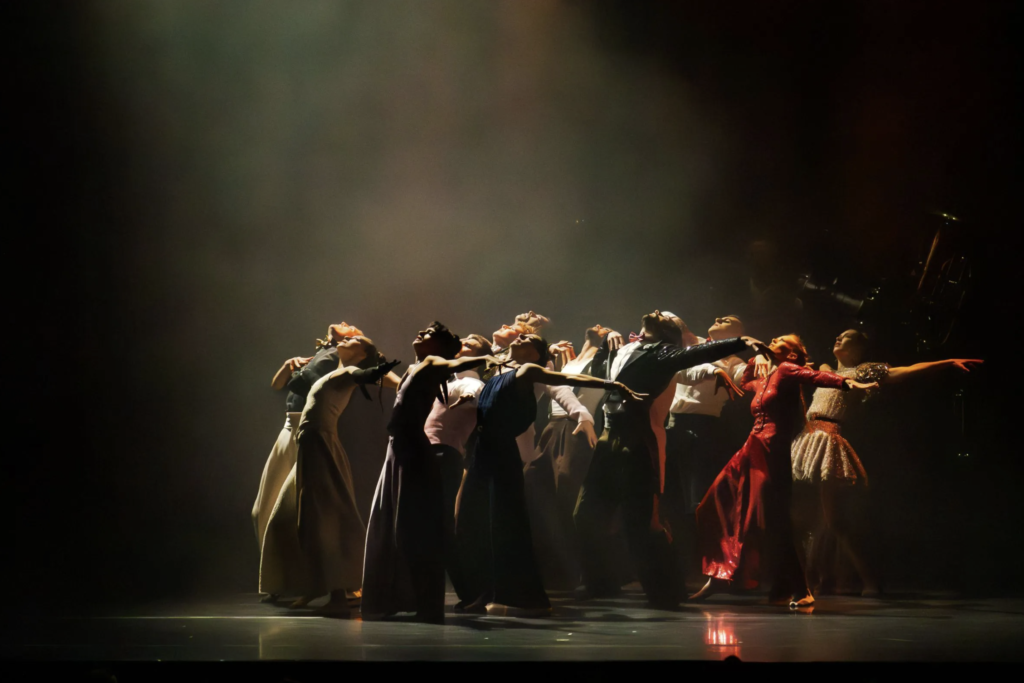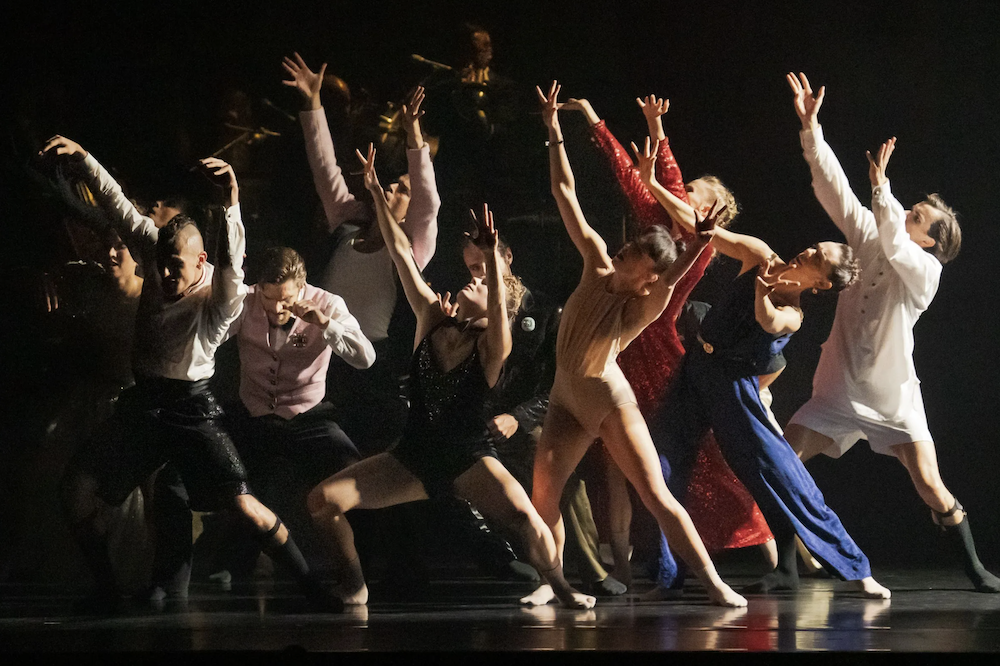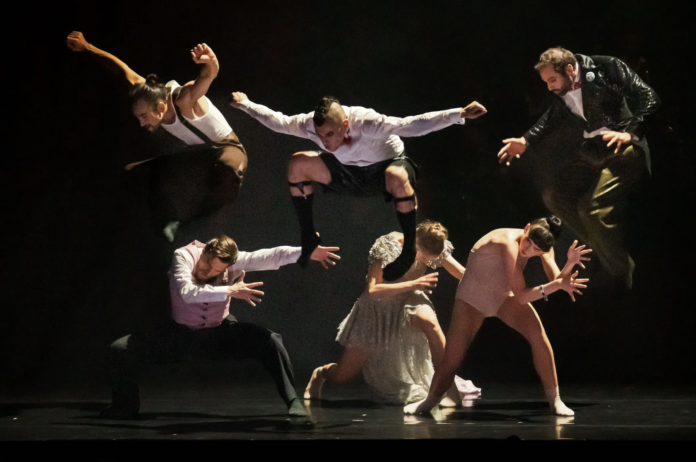I wanted to fall head-over-heels in love with Paris Opera Ballet’s North American premiere of Red Carpet, a new ballet by Israeli choreographer Hofesh Shechter. After all, it had among its unquestionable pedigreed assets 13 of the company’s inimitable dancers, costumes designed by Chanel, a dynamo set, and music by none other than Shechter himself—not to mention, a spectacular four-member jazz-rock band.
It was presented by Cal Performances October 2-4, one of only two U.S. stops on the company’s tour. (The other was New York.) In summary, the performance represented a real coupe, adding a prized feather to the organization’s already highly decorated cap.
And so it was with all manner of promise and high hopes the curtain rose on the 75-minute work, an investigation of red carpets—their glamour, traditions, history, celebrity associations, and more. The grim underbelly of glamour, in Shechter’s imagination is grotesqueness, grit, grime, and ambiguity. All of this made its way into the abstract narrative. The set, lighting, music, and pacing of the London-based choreographer’s ballet were evocative of an underground cabaret or a warehouse nightclub in which a rave that begins at midnight continues for days, perhaps to the dawn of a new era.
The company’s dancers are best known for their mastery of classical ballets such as Swan Lake, Giselle, and the like. But in Red Carpet, they abandoned tradition and cavorted like swans on steroids. Tossing aside their pointe shoes, pink tights, and tutus, the dancers launched into outer orbit propelled by the stunning band. The abandon was wanton, the energy maxxed, the overall race pace interrupted only by sporadic lava lamp-like episodes that feel like group hallucinations or slow, touch-less orgies.
The spectacle cannot be fully described without mention of the glorious chandelier upon which the curtain opens. Decadently laden with amber lights, it was magnificent; its draped loops and curvaceous branches resembling spider legs dressed in maroon or black velvet tights. The eye could do nothing but follow as the chandelier slowly rose on the scene—and jump to look at it at numerous times throughout the performance. Lighting designer Tom Visser demonstrated his uncanny skill by producing shifting moods that bring to mind European concert halls such as the company’s home theater, the Palais Garnier, or that bounced effervescently from elegance to smelly, tawdry, more commercial impressions.
Chanel’s costumes included the expected amount of sequins, seductiveness, and variety: a stunning red gown, chic tuxedo with skintight, biker-like pants, plain brown work pants paired with a white muscle T and suspenders, a blousy pajama-like adult onesie, and in the final scenes, the dancers in pale, skin-clinging costumes resembling underwear. It was Broadway, the boudoir, the back alley, and effectively fashioned.

The dancers, for all their brilliant stomping and spinning, moved seamlessly in and out of tight formations, commitment in every gesture, hip thrust, and (too long, too many) wavy and fluid undulation sections. Their interactions recalled like those times when everyone talks and no one listens—perhaps a deliberate condition set up by Shechter to emphasize grossness—and was only interesting for about 20 minutes.
After that, the distancing seemed like a stop sign, a stumbling block that kept the ballet from moving forward, backwards, sideways, up, or down. Circling in endless loops can be effective in any piece of art, but ultimately, one wants to move or be moved. A person craves surprise within repeating patterns. Art forms, ballet in this case, must push its own parameters to remain relevant. Ballet must not be satisfied and imprisoned in constructions that parallel the past or other works already on the scene.
Of course, Shechter is is talented and there were some non-flat elements that rose like welcome pillars in the dessert-like terrain. A too-short solo performed at the Sunday matinee by dancer Takeru Coste was breathtaking and emotional, a random double frappé tossed into another dancer’s cabaret style phrase suddenly seemed subversive. Slower moments offered fascinating voyeurism: watching sultry solo disrobing or being allowed to rest the eye on stilled tableaus of dancers who stood with arms lifted like human menorahs or posed in arrangements that mirrored friezes on ancient tombstones and buildings.

Highest of all were the passages featuring the band, especially when music collaborator and drummer Yaron Engler unleashed his fearsome vocals and wailed like a newborn child or a mythical fairy or mighty god. The music was visceral, raw, heart-scorching and eery; everything the ballet could have been but merely tapped on. Thinking the ballet could use a good 20-minute trim, I left the theater wishing more time had been allotted to the band, rendering something that would grow richer in memory.
It might surprise a person to learn that having had this response to Red Carpet, it provides great pleasure to read reviews written by others who differ and adored the new work. Equally gratifying, the audience in Berkeley instantly cheered and rose to its feet, offering extended applause after the final curtain descended. Each ballet speaks differently to different people and so it should, so it must, if the art form is to be a lived human experience, a breathing entity that attracts interest, attention, disagreement, consensus, discussion, and other responses.
Freedom to like or question is a commodity in short supply these days. The world of ballet—dare we say all art—is better off for anyone having seen Red Carpet and come away with a personal, completely unique response. Cheers to that.





